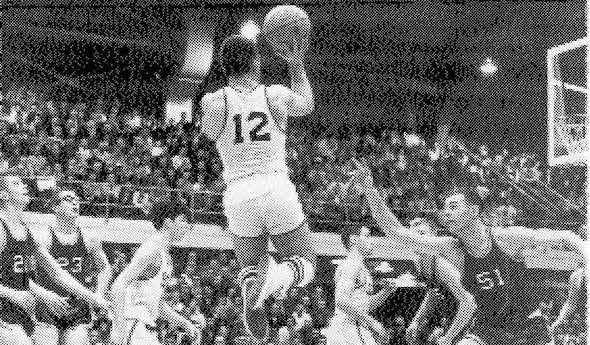
Tales of Teams, Trophies & Trinkets - Vol 2
By
Ron Pesch
MHSAA historian
February 9, 2017
A picture may be worth a thousand words – but often, we can learn as much from a traveling trophy, game ticket, and even an old megaphone.
Michigan’s high school sports history is more than a century old and filled with legends passed on of games, teams and athletes and the roles they played as our communities rolled forward toward present day. Following up last year’s “Tales of Teams, Trophies & Trinkets,” we present a second chapter highlighting artifacts that tell some of those stories.
|
1909 |
Saginaw vs. Saginaw Arthur Hill |
Football Trophy |
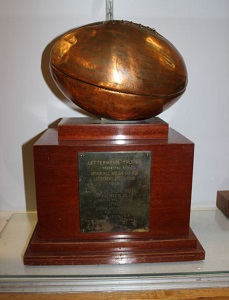 This bronzed football was the original used in the 1909 Thanksgiving Day contest played between Saginaw High and Saginaw Arthur Hill, and won by Saginaw, 5-0 at Burkart Park. In 1948, the ball was stylized into a trophy by the Letterman’s Associations of the rival schools, designed to travel between schools as the reward for winning the annual contest. When the Lumberjacks of Arthur Hill ripped off 24 straight victories beginning in 1971 (the teams played twice in 1974), ownership of the trophy was mostly forgotten. When talk of closing Saginaw High School mounted, the trophy was placed on display at Saginaw’s Castle Museum, then donated to the Saginaw County Sports Hall of Fame.
This bronzed football was the original used in the 1909 Thanksgiving Day contest played between Saginaw High and Saginaw Arthur Hill, and won by Saginaw, 5-0 at Burkart Park. In 1948, the ball was stylized into a trophy by the Letterman’s Associations of the rival schools, designed to travel between schools as the reward for winning the annual contest. When the Lumberjacks of Arthur Hill ripped off 24 straight victories beginning in 1971 (the teams played twice in 1974), ownership of the trophy was mostly forgotten. When talk of closing Saginaw High School mounted, the trophy was placed on display at Saginaw’s Castle Museum, then donated to the Saginaw County Sports Hall of Fame.
According to Jeffrey Cottrell, the multi-media specialist at the Historical Society of Saginaw County, when plans to close Saginaw High did not materialize, “it was decided amongst the Saginaw County Sports Hall of Fame and the Arthur Hill Letterwinners Association that it was time to put it back into use. This past fall, the Sports Hall of Fame awarded the trophy to Saginaw High when they beat Arthur Hill 40-0.”
Going forward, the Letterman's Trophy will continue to be presented to the winner of the football game between the Trojans and the Lumberjacks.
|
1921 |
Detroit Cass Tech vs. Flint Central |
Football Program |
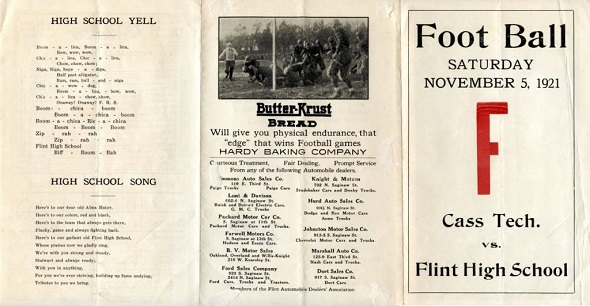
A crowd of 2,500 was on hand for this contest as Detroit Cass Tech downed Flint Central, 34-20, in an aerial battle between the squads. The Detroit Free Press arraigned for a special interurban run, with special railcars earmarked for Cass Tech students interested in attending the Saturday game at Flint. Between 200 to 300 made the trip to cheer their team to victory.
Flint Central completed 14 of 34 passes for 176 yards, but was intercepted on six occasions. Cass Tech arms were accurate on only 7 of 24 attempts for 160 yards, with four interceptions, but two completions went for touchdowns of 18 yards and 50 yards. A third pass of 35 yards helped set up the visitor’s first score. Bruno Murkobred, Cass Tech’s speedy quarterback, was the star of the contest, scoring three of his team’s five touchdowns.
|
1939 |
Kalamazoo Central vs. Battle Creek Central |
Basketball Program |
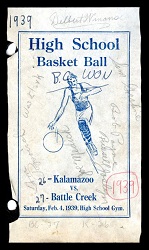 This tattered memento, from a scrapbook kept by historian Dick Kishpaugh, illustrates the modest design of a high school basketball program back in 1939. Likely created by the high school print shop, this single sheet, printed specifically for distribution at the game, features autographs gathered by its owner. Wes Clark, one of the names captured on the cover, led Battle Creek Central with 10 points, including a pair of buckets in the final minute to secure a 27-26 win by the Bearcats.
This tattered memento, from a scrapbook kept by historian Dick Kishpaugh, illustrates the modest design of a high school basketball program back in 1939. Likely created by the high school print shop, this single sheet, printed specifically for distribution at the game, features autographs gathered by its owner. Wes Clark, one of the names captured on the cover, led Battle Creek Central with 10 points, including a pair of buckets in the final minute to secure a 27-26 win by the Bearcats.
Newspaper reports from the time indicate that halftime of the contest would feature “a table tennis exhibition between Helen Van Dyke of Flint, four-time state champion, and Floyd Painter, Battle Creek champion.” Miss Van Dyke was a sophomore at Olivet College at the time.
|
1940 |
Lansing Eastern vs. Lansing Central |
Football Program |
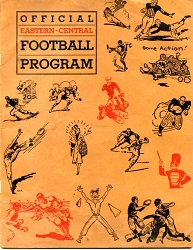 This is the program cover from the 13th annual Football Classic between the Quakers of Eastern and the Big Reds of Central. Fans were requested to “refrain from making unnecessary noise as they drive away from the stadium … due to the nearness of Sparrow Hospital.”
This is the program cover from the 13th annual Football Classic between the Quakers of Eastern and the Big Reds of Central. Fans were requested to “refrain from making unnecessary noise as they drive away from the stadium … due to the nearness of Sparrow Hospital.”
At the time of the 1940 contest, Lansing Central led the series with six wins against five defeats. The series featured a single tie, a 6-6 result in 1935.
Eastern’s 1940 squad, coached by Walter Graff, was able to knot the series at six wins apiece with a thrilling 7- 6 victory over the crosstown rivals, coached by Al Bovard.
The 16-page document was hand set and printed by the Eastern and Central High School Vocational Printing Classes, and included rosters, messages from the two school principals and athletic directors, as well as comments from each member of the coaching staffs, team captains, student council presidents and numerous team members from each school with their views on the game. Of course there is a photograph of each high school football team, but also photos of each band, their directors, and a list of the band members for both Eastern and Central. Finally, there are photos of the Eastern and Central Yell Leaders, nine for the Quakers and six for the Big Reds.
It is a true work of art.
|
1950 |
Central Michigan College Relays |
Track Medal |
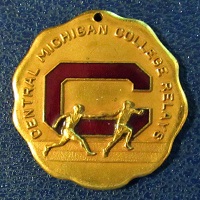 More than 2,300 athletes from 97 high schools descended upon Mt. Pleasant for the Tenth Annual Central Michigan Relays. Ecorse in Class B and Flint School for the Deaf in Class D earned team titles on Friday, May 5th while on Saturday, the 6th, Flint Northern and Milan won Class A and Class C, respectively. Six event records fell during the two-day event, three in the broad jump.
More than 2,300 athletes from 97 high schools descended upon Mt. Pleasant for the Tenth Annual Central Michigan Relays. Ecorse in Class B and Flint School for the Deaf in Class D earned team titles on Friday, May 5th while on Saturday, the 6th, Flint Northern and Milan won Class A and Class C, respectively. Six event records fell during the two-day event, three in the broad jump.
This medal, honoring a member of the winning Class C sprint relay team, was awarded at the event. The winning team, and therefore, the name of the individual awarded the medal, remain a mystery.
|
1962 |
Saginaw Sacred Heart |
Megaphone |
 As at the majority of schools across the state at the time, athletic competition against other schools was not an option for Gloria Groll and her female classmates during her days as a student at Saginaw Holy Rosary High School. So, from the fall of 1959 until her graduation with 27 other students in the spring of 1962, she was a cheerleader for the Greyhounds. This beautiful megaphone, donated by Groll to the Saginaw County Sports Hall of Fame, is a memento from those times.
As at the majority of schools across the state at the time, athletic competition against other schools was not an option for Gloria Groll and her female classmates during her days as a student at Saginaw Holy Rosary High School. So, from the fall of 1959 until her graduation with 27 other students in the spring of 1962, she was a cheerleader for the Greyhounds. This beautiful megaphone, donated by Groll to the Saginaw County Sports Hall of Fame, is a memento from those times.
Holy Rosary was one of nine Catholic high schools operating in the Saginaw area in the 1950s and 1960s. Population shifts from the cities to the suburbs over the coming years would impact enrollment figures at schools nationally. In Saginaw, the opening of the Buena Vista School District in 1956 directly impacted Holy Rosary. In 1970 the school closed. A year later only three schools – SS Peter and Paul, St. Mary and Saginaw St. Stephen – remained. In 1984, those schools were consolidated to form Saginaw Nouvel Catholic Central.
|
1963 & 1930 |
Grosse Pointe St. Paul |
League Trophies |
 On the left, we find the trophy awarded to Grosse Pointe St. Paul's after winning the 1963 city championship. Bob Martin, a 6-foot-6 junior who earned first division all-Catholic honors, scored 14 of his 22 points in the fourth quarter to lead the Lakers to a 55-46 upset-victory over Detroit Pershing. The game was played at University of Detroit Memorial before 6,979 spectators. It was the first time since 1958 that the Catholic League won the annual matchup with the champions of the Public School League.
On the left, we find the trophy awarded to Grosse Pointe St. Paul's after winning the 1963 city championship. Bob Martin, a 6-foot-6 junior who earned first division all-Catholic honors, scored 14 of his 22 points in the fourth quarter to lead the Lakers to a 55-46 upset-victory over Detroit Pershing. The game was played at University of Detroit Memorial before 6,979 spectators. It was the first time since 1958 that the Catholic League won the annual matchup with the champions of the Public School League.
To the right is the trophy awarded to St. Paul for winning the first golf tournament of the South Michigan Catholic High School League. The school's four golfers shot 710 over 36 holes on the day, 69 fewer strokes than second-place Detroit St. Rose. Played at Clinton Valley, the event saw Bill Beaupre win individual honors with a total of 158, including 76 in the morning. His cousin and teammate, Harold Beaupre, finished second with 169, while Peter Bononis of Detroit Holy Name was third with 171 strokes.
|
1965 |
Fennville vs. Kalamazoo Hackett |
Ticket Stub |
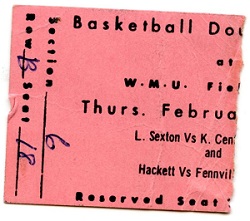 This ticket stub from a doubleheader hosted at Western Michigan University’s Read Fieldhouse on February 18, 1965 was the first chance for many to witness lightning in a bottle. A capacity-plus crowd of 9,100 fans slid through the gate to watch a rumor.
This ticket stub from a doubleheader hosted at Western Michigan University’s Read Fieldhouse on February 18, 1965 was the first chance for many to witness lightning in a bottle. A capacity-plus crowd of 9,100 fans slid through the gate to watch a rumor.
The antics of 5-foot-7½ guard Richie Jordan had been talked about around the Kalamazoo area, but few had actually seen him play. His skills were on full display on this Thursday night, as he netted a fieldhouse scoring record with 49 points in a come-from-behind 76-72 win over a much taller team from Kalamazoo Hackett. Jordan’s output during the evening’s second game eclipsed the 45 points Manny Newsome scored for Western Michigan University against Toledo, just over a year before.
The evening hadn’t started well. According to the Kalamazoo Gazette, “Jordan hit only six of his 13 field shots in the first half and threw the ball away eight times. Trailing Hackett by 17 points, 50-33, with two minutes to play in the third quarter, the Blackhawks were able to cut the deficit to 13, 60-47 as the teams entered the final frame.
Quickly, everyone in the fieldhouse knew who was getting the ball during the comeback attempt. Jordan grabbed control; with his drives for layups and “softly-arched” jump shots against intense pressure, he hit seven of nine field goals, wowing the crowd. With 2:36 to play, Jordan nailed a pair of free throws to tie the game at 72 all. Then, with 57 seconds left, the “Fennville Flash” nailed the go-ahead basket, followed by two insurance free throws to seal the win. For many, his 24 points in the fourth quarter sealed his journey from rumor to legend and, no doubt, inspired the single-sentence first paragraph of the next morning’s coverage in the Gazette.
“Yes, there is a Richie Jordan!”
(P.S. – Kalamazoo Central upset eighth-ranked Lansing Sexton, 67-57, in the evening’s opening contest).
 Ron Pesch has taken an active role in researching the history of MHSAA events since 1985 and began writing for MHSAA Finals programs in 1986, adding additional features and "flashbacks" in 1992. He inherited the title of MHSAA historian from the late Dick Kishpaugh following the 1993-94 school year, and resides in Muskegon. Contact him at [email protected] with ideas for historical articles.
Ron Pesch has taken an active role in researching the history of MHSAA events since 1985 and began writing for MHSAA Finals programs in 1986, adding additional features and "flashbacks" in 1992. He inherited the title of MHSAA historian from the late Dick Kishpaugh following the 1993-94 school year, and resides in Muskegon. Contact him at [email protected] with ideas for historical articles.
PHOTO: Fennville's Richie Jordan pulls up for a jumper, showing off the form that's become iconic when recalling the high school phenom. (Photos of Letterman's Trophy and Megaphone were provided by Jeffery Cottrell, and photo of Grosse Pointe trophies was provided by Bill Roose.)
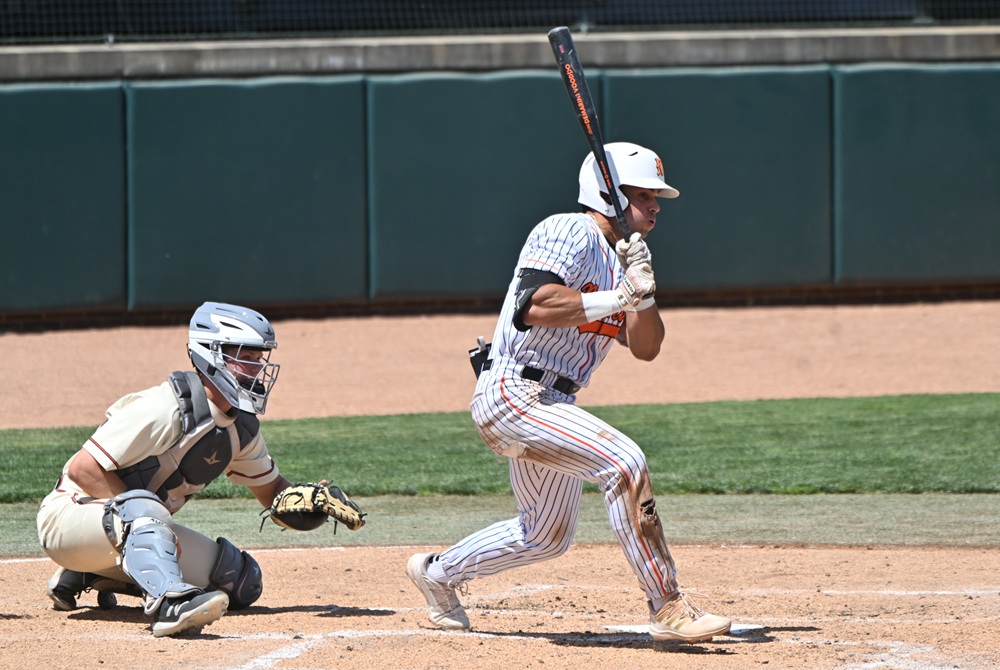
Northville Slugger Makes Memorable Marks on Way to Pro Baseball Stardom
By
Geoff Kimmerly
MHSAA.com senior editor
January 16, 2026
Dante’ Nori capped his high school baseball career in 2024 by leading Northville to the Division 1 championship – and cementing himself in the record book for a handful of individual accomplishments.
He finished his four seasons fourth all-time with 120 walks, fifth with 21 triples and 10th with 193 runs scored, plus is listed twice for single-season triples with a high of eight as a junior.
Nori was drafted in the first round of the 2024 Major League Baseball draft by the Philadelphia Phillies and reached Class AA last season.
See below for several recently-added listings to the baseball record book, and click the heading to see the record book in full. Several more applications have been received and are in the process of being confirmed.
Baseball
A pair of Montague standouts made the records during the 2023 season . Then-senior Nick Moss was added for hitting safely in 13 straight at bats from May 6-16, and classmate Kade Johnson made the single-season triples list with seven. Moss is slated to play next at Milligan in Tennessee.
Niles Brandywine basketball standout Jamier Palmer made the record book as a junior in 2023 with 55 stolen bases, stole 52 a year later, and finished his four-year career with 177 (tied for third-most) among four record book career listings – he also had 154 runs, 26 times hit by pitches and a .464 average over 109 games. He was joined by senior Owen Hulett, who is listed for a 1.13 career ERA over three seasons. Hulett played at Lake Michigan College, and Palmer played baseball and basketball at Kalamazoo Valley Community College.
White Cloud’s Alex Cruzan made getting hit by pitches a key way to get on base during his three-season varsity career that ended in 2023. He was twice added for the HBPs in a game as a senior and for 16 total that spring – plus 42 for his career, which ranks 12th all-time.
Alex Fenkell finished his Birmingham Groves career in 2022 on the career batting average list at .459 and also on the single-season triples list with eight as a junior. Those eight contributed to Groves making the team triples list with 20 that season, and they also stole 12 bases in a game that spring. Fenkell is continuing at Kalamazoo College.
Portage Northern was menacing on the basepaths during the 2023 season, stealing 182 bases over 32 games. That total tied for 11th-most for one season.
Thomas Fox had seven hits last season as a junior in 2023, but led Johannesburg-Lewiston with a .644 on-base percentage in part thanks to being hit by 35 pitches over 33 games. That set a single-season MHSAA record in the category, and he also was listed four times for three HBPs in one game – including in both halves of a doubleheader.
Farmington earned six total entries for stolen bases in 2024, led by then-senior Owen Matteson’s two for stealing six in one game and 56 total. Farmington also made the team record book with 16 stolen bases in a game twice and 170 for the season over 34 games. Matteson is continuing his career at Jackson College.
Algonac standout Josh Kasner finished his four-year varsity career in 2024 on the career wins list with a 33-5 record, on the career ERA list at 1.06 and on the career strikeouts list with 449 over 257 1/3 innings pitched. He appears on the single-season ERA list three times including with a career-best 0.59 as a senior, and was joined that season by teammate Bryce Simpson at 0.93. Teammate Cole Thaler also was added for being hit by three pitches in one game that spring. Kasner plays at Michigan, Simpson graduated in 2025 at plays at Wayne State and Thaler is a senior this school year. Algonac as a team also was added for a 37-4 record, 352 strikeouts and 1.47 ERA during the 2023 season.
Rudyard earned its first team record book entry on May 25, 2021, when the team stole 15 bases in a 7-4 win over Pickford. Seven players contributed to the total, which is tied for 15th all-time for a single game.
More than a half-century later, one of the most magnificent pitchers’ duels has taken its place in the record book. On June 6, 1969, Hamtramck St. Ladislaus defeated Detroit St. Hedwig 1-0 in 14 innings to decide a Catholic High School League championship at Tiger Stadium. Doug Konieczny struck out 28 for St. Ladislaus – that total ranking fourth all-time – and St. Hedwig’s Carey Wyler struck out 22. Wyler, a senior that season, also made the single-season ERA list with a 0.15 across 62 innings. Konieczny went on to play at St. Clair County Community College and was drafted by both the Detroit Tigers and Houston Astros, the latter with the third overall pick in the 1971. He played four seasons with Houston.
Conor Rentfrow earned Brooklyn Columbia Central’s second baseball record book listing with 19 doubles in 2024. He’s a senior and committed to Taylor (Indiana).
Holt’s Mitchell Dubois became his program’s latest to reach the record book, pitching to a 0.69 ERA in 2024 over 61 1/3 innings. He graduated last spring and is playing at Spring Arbor.
Kingsley’s Garrett Martz found an additional way to pump up his on-base percentage as a junior in 2024. In addition to hitting .326, Martz was hit by pitches 19 times, which is tied for 15th-most for a single-season.
East Jordan’s Korbyn Russell finished his three-season varsity career this spring with six record book listings including some of the highest strikeout-per-game averages of all time. He had a 0.34 ERA as a senior and 1.14 ERA for his career, striking out 15.6 batters per game both as a junior and senior. He totaled 392 strikeouts over his three seasons and finished with an average of 13.9 strikeouts per game for his career, which ranks third all-time. He’ll continue his career at Aquinas.
Paw Paw earned its second and third listings in 2024 for being hit by pitch, on the team list with 49 over 35 games and with senior Jacob Major on the individual list with 30 over four seasons. Teammate Jake Hindenach made the single-season triples list with eight. Major is continuing at Lake Michigan College, and Hindenach at Kellogg Community College.
Frankfort’s Rylan Lewis was added for eight triples over 32 games in 2024 as a sophomore.
Millington made the team record book lists two straight seasons for stolen bases, swiping 169 over 31 games in 2024 and 170 over 40 games in 2023. Then-junior Truk Terbush made the individual list with 50 steals in 2023 and is continuing at Delta College.
Onsted’s Alex Schmidt tied for the 10th-most times being hit by a pitch last season, with 21 over 34 games as a senior in 2024.
Powers North Central’s Adrian Mercier completed a four-year varsity career in 2024 among the leaders in career batting average at .522, which ranks ninth. His .619 hit during his junior season, which continues to rank 10th all-time. He’s playing at Lakeland in Wisconsin.
Daniel Robinson had 76 hits for Grosse Pointe North in 2015, at the time ranking fifth and still tied for ninth-most all-time. A senior that season, he went on to play at Central Michigan and two seasons with Los Angeles Dodgers minor-league affiliates.
Schoolcraft’s Jacob Taylor finished sophomore year in 2024 tying for the fifth-most times hit by pitch during a season – 24 over 39 games. Now a senior, he will continue at Aquinas.
Flint Powers Catholic won the Division 2 championship in 2024 in part on the arm of Grant Garman, who capped a four-year varsity career with nine record book listings. He was 14-0 as a senior to make the single-season wins list and finished tied for fourth on the career wins list with 45. His 0.71 career ERA ranks fifth, and his 446 strikeouts over 284 innings rank 16th. He played at Oakland and will continue at Hawaii.
Fran Love earned Ann Arbor Greenhills’ first record book listing in this sport with a 0.81 ERA during the 2024 season, when he finished 7-1. He graduated last spring and plays at Alma College.
Ryan Zweng capped his four-year varsity career at Union City in 2024 on four career lists, with 175 hits, 159 runs, 131 RBI and 27 times hit by pitch over 134 games. He made the Division 3 all-state first team in 2024, his school’s first first-team all-state selection since 2000.
Bridgman’s Alec MacMartin added 26 more hit-by-pitches as a senior in 2024 for this third single-season listing in that category – and finished with a record 83 over three varsity seasons.
Ottawa Lake Whiteford ranked 13th for strikeouts as a team during the 2024 season. The Bobcats fanned 314 over 36 games.
Watervliet recent run of success has included a lot of success running the base paths, as the team was added for 222 stolen bases during its Division 3 championship season in 2024 and 208 stolen bases in 2023, with Wyatt Epple (121) and Chase Tremblay (112) both added to the individual stolen base career list for their four-year runs ending that title-winning spring. Epple also was added for 183 career hits, 182 career runs, 48 career doubles and 12 career triples. Travis Bolin was added for 13 career triples and 106 career stolen bases from 2010-13, which also included Watervliet as a team making the stolen bases list again with 214 in 2012. Epple is playing at Davenport, and Bolin played there as well.
Three Rivers’ Gabe Young made the single-game stolen bases list with five against Coldwater last April 17. He’s currently a junior. Plainwell’s Andrew Hampton also made the single-game stolen bases list, with seven against Sturgis on April 29 to tie for third-most in one game. He’s a senior. Jadn’ McGowen made the single-game stolen bases list for Wyandotte Roosevelt with six against Plymouth Christian Academy on April 4. He was a senior and is continuing at Madonna. Haslett’s Ayden Smith also was added for five stolen bases in his team’s win over Jackson Northwest on May 15. Smith has committed to continue at Henry Ford College after this upcoming season.
Stockbridge’s Jayden Pilch tied for third on the single game hit-by-pitch list, getting hit by three against Reading on May 1. The then-senior also made the single-season list with 21 HBPs over 31 games.
Richland Gull Lake ranked fourth all-time last spring in being hit by pitches 82 times. The Blue Devils finished 31-7.
Bangor’s Jaret McCoy stole 62 bases in 63 attempts in 2025 to tie for 10th-most steals. He’s a junior this school year. Wyoming’s Donnie Petree also made the single-season steals list last spring with 49 to cap his career.
Kingston’s Isaiah Helton’s dominance on the mound resulted in some of the most impressive strikeout numbers in MHSAA history. He posted 456 strikeouts in 222 1/3 innings from 2021-24, making the career total strikeouts list but also the career strikeouts per game list at 14.4. He made the single-season strikeouts per game list as both a junior (15.95) and senior (16.15).
Napoleon’s Collin Bradley completed his four-year varsity career in 2019 all over the record book on the way to finishing with a 36-6 career pitching record. He had eight shutouts over his career, including three no-hitters as a senior, and made ERA lists at 0.23 as a senior and 1.59 for his career. He also totaled 20 strikeouts in a seven-inning game, 15.8 per game as a senior, and 364 for his career. He went on to play at Grand Rapids Community College and Grand Valley State. Younger brother Grant Bradley earned seven record book listings during his career from 2021-24, including for eight shutouts, five no-hitters, a career 1.61 ERA and 845 strikeouts over 226 2/3 innings pitched. Grant Bradley is continuing at Michigan.
Hudsonville batters were hit by pitches 99 times over 41 games last spring, the second-highest total in MHSAA baseball history. Braylon Miller made the individual list with 16; he’s a senior this school year.
Mount Pleasant Sacred Heart’s Grady Pieratt earned nine record book listings over his four seasons and 149 games ending last spring, including a few of the highest in their respective categories. He finished third in career runs with 238, sixth in career hits at 210, second in career stolen bases with 178, and tied for 11th with 17 career triples, including 11 (tying for sixth-most for a season) as a senior. His 60 stolen bases as a junior tied for 12th on that list. Teammate Connor Stempky was added for 158 career runs, 140 career RBI and 98 career walks from 2021-24, and Aidan Halliday was added for 141 career RBI also from 2021-24. Pieratt is playing at Alma College, and Halliday plays football at Northwood.
Benji Allen finished his Maple City Glen Lake career last spring with 11 record book listings including for a .500 career average, 150 career runs scored, 48 times hit by pitch (ranking seventh) and a career ERA of 1.63. He was joined by teammate Cooper Bufalini, who was added for 44 times hit by pitch and a 1.10 career ERA; both played from 2022-25. Peter Gelsinger was added for being hit by pitches 33 times during the same career tenure, while Isaac Hlavka was added for a 0.99 ERA this past season. Glen Lake also was added several times for team record categories, and coach Kris Herman was added to the all-time wins list with a record of 504-242-8 since 2005. Allen is playing football at Grand Valley State.
PHOTO Northville’s Dante Nori (6) turns on a pitch during his team’s 2024 Division 1 championship game win over Bloomfield Hills Brother Rice.

